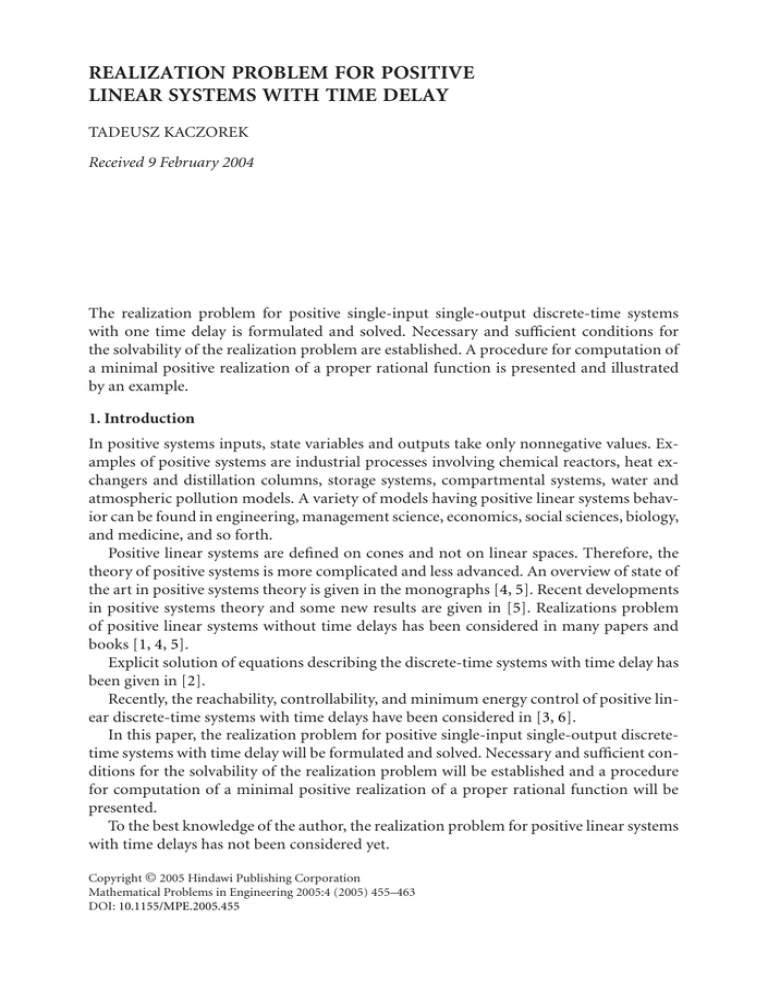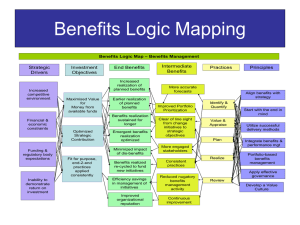REALIZATION PROBLEM FOR POSITIVE LINEAR SYSTEMS WITH TIME DELAY
advertisement

REALIZATION PROBLEM FOR POSITIVE
LINEAR SYSTEMS WITH TIME DELAY
TADEUSZ KACZOREK
Received 9 February 2004
The realization problem for positive single-input single-output discrete-time systems
with one time delay is formulated and solved. Necessary and sufficient conditions for
the solvability of the realization problem are established. A procedure for computation of
a minimal positive realization of a proper rational function is presented and illustrated
by an example.
1. Introduction
In positive systems inputs, state variables and outputs take only nonnegative values. Examples of positive systems are industrial processes involving chemical reactors, heat exchangers and distillation columns, storage systems, compartmental systems, water and
atmospheric pollution models. A variety of models having positive linear systems behavior can be found in engineering, management science, economics, social sciences, biology,
and medicine, and so forth.
Positive linear systems are defined on cones and not on linear spaces. Therefore, the
theory of positive systems is more complicated and less advanced. An overview of state of
the art in positive systems theory is given in the monographs [4, 5]. Recent developments
in positive systems theory and some new results are given in [5]. Realizations problem
of positive linear systems without time delays has been considered in many papers and
books [1, 4, 5].
Explicit solution of equations describing the discrete-time systems with time delay has
been given in [2].
Recently, the reachability, controllability, and minimum energy control of positive linear discrete-time systems with time delays have been considered in [3, 6].
In this paper, the realization problem for positive single-input single-output discretetime systems with time delay will be formulated and solved. Necessary and sufficient conditions for the solvability of the realization problem will be established and a procedure
for computation of a minimal positive realization of a proper rational function will be
presented.
To the best knowledge of the author, the realization problem for positive linear systems
with time delays has not been considered yet.
Copyright © 2005 Hindawi Publishing Corporation
Mathematical Problems in Engineering 2005:4 (2005) 455–463
DOI: 10.1155/MPE.2005.455
456
Realization problem for positive linear systems with time delay
2. Problem formulation
Consider the single-input single-output discrete-time linear system with one time delay
xi+1 = A0 xi + A1 xi−1 + bui ,
i ∈ Z+ = {0,1,...},
yi = cxi + dui ,
(2.1a)
(2.1b)
where xi ∈ Rn , ui ∈ R, yi ∈ R are the state vector, input, and output, respectively, and
Ak ∈ Rn×n , k = 0,1, b ∈ Rn , c ∈ R1×n , and d ∈ R.
Initial conditions for (2.1a) are given by
x−1 ,x0 ∈ Rn .
(2.2)
Let R+n×m be the set of n × m real matrices with nonnegative entries and Rn+ = R+n×1 .
Definition 2.1 (see [3]). The system (2.1) is called (internally) positive if for every x−1 ,x0 ∈
Rn+ and all inputs ui ∈ R+ , i ∈ Z+ , xi ∈ Rn+ and yi ∈ R+ for i ∈ Z+ .
Theorem 2.2 (see [3]). The system (2.1) is positive if and only if
A0 ∈ R+n×n ,
A1 ∈ R+n×n ,
b ∈ Rn+ ,
c ∈ R1+×n ,
d ∈ R+ .
(2.3)
The transfer function of (2.1) is given by
T(z) = c In z − A0 − A1 z−1
−1
b + d.
(2.4)
Definition 2.3. Matrices (2.3) are called positive realizations of a given proper rational
function T(z) if and only if they satisfy the equality (2.4). A realization (2.3) is called
minimal if and only if the dimension n of A0 and A1 is minimal among all realizations
of T(z).
The positive realization problem can be stated as follows.
Given a proper rational function T(z), find a positive realization (2.3) of the rational
function T(z).
Necessary and sufficient conditions for the solvability of the problem will be established and a procedure for computation of a positive realization will be presented.
3. Problem solution
The transfer function (2.4) can be rewritten in the form
T(z) = c z−1 In z2 − A0 z − A1
=
where
d(z) = det
b+d
cz In
zl(z)
0 z − A1 ad b
+d =
+ d,
2
d(z)
det In z − A0 z − A1
(3.1)
2(n−1)
+ l2n−3 z2n−3 + · · · + l1 z + l0 ,
ad b = l2(n−1) z
In z2 − A0 z − A1 = z2n − a2n−1 z2n−1 − · · · − a1 z − a0 ,
l(z) = c In z2 − A0 z − A1
z2 − A
−1
and [In z2 − A0 z − A1 ]ad denotes the adjoint matrix for [In z2 − A0 z − A1 ].
(3.2)
Tadeusz Kaczorek 457
From (3.1), we have
d = limz→∞ T(z)
(3.3)
since limz→∞ [z−1 (In z2 − A0 z − A1 )]−1 = 0.
The strictly proper part of T(z) is given by
Tsp (z) = T(z) − d =
zl(z)
.
d(z)
(3.4)
Therefore, the positive realization problem has been reduced to finding matrices
A0 ∈ R+n×n ,
A1 ∈ R+n×n ,
b ∈ Rn+ ,
c ∈ R1+×n
(3.5)
for a given strictly proper rational matrix (3.4).
Lemma 3.1. The strictly proper transfer function (3.4) has the form
(z) =
Tsp
l(z)
d (z)
(3.6)
if and only if detA1 = 0, where
d (z) = z2n−1 − a2n−1 z2n−2 − · · · − a2 z − a1 .
(3.7)
Proof. From the definition of (3.2) of d(z) for z = 0, it follows that a0 = detA1 . Note that
d(z) = zd (z) if and only if a0 = 0 and (3.4) can be reduced to (3.6).
Lemma 3.2. If the matrices A0 and A1 have the forms
0
a1
a3
.
A0 =
..
a2n−7
a
2n−5
0
0
a0
a2
..
.
A1 =
a2(n−4)
a
2(n−3)
0
0 ···
0 ···
0 ···
.. . .
.
.
0 ···
0 ···
0 ···
0 ···
0 ···
1 ···
.. . .
.
.
0 ···
0 ···
0 ···
0
0
0
..
.
0
0
0
..
.
∈ R n ×n ,
0
a2n−3
0
0
0 a2n−1
0 0
1
0 0
0
0 0
0
..
.. ..
∈ R n ×n ,
.
. .
0 0
0
1 0 a2(n−2)
0 1 a2(n−1)
(3.8)
458
Realization problem for positive linear systems with time delay
then
det In z2 − A0 z − A1 = z2n − a2n−1 z2n−1 − a2(n−1) z2(n−1) − · · · − a1 z − a0 .
(3.9)
Proof. Expansion of the determinant with respect to the first row yields
det In z2 − A0 z − A1
z2
−a1 z − a0
−a3 z − a2
..
=
.
−a2n−7 z − a2(n−4)
−a2n−5 z − a2(n−3)
0
0 ···
z2 · · ·
−1 · · ·
..
..
.
.
0 ···
0 ···
0 ···
0
0
0
..
.
0
0
0
..
.
z2
0
−1 z2
0 −1
0
0
..
.
0
−a2n−3 z − a2(n−2) z2 − a2n−1 z − a2(n−1) −1
= z2(n−2) z4 − a2n−1 z3 − a2(n−1) z2 − a2n−3 z − a2(n−2) + (−1)n
−a 1 z − a 0
z2 0 · · · 0
0
2 ···
−
a
z
−
a
−
1
z
0
0
3
2
.
.
.
.
.
.
.
.
.
.
.
.
.
.
.
.
.
.
= ···
×
2
−a2n−7 z − a2(n−4)
0
0
·
·
·
z
0
−a
2
0
0 · · · −1 z 2n−5 z − a2(n−3)
0
0
0 · · · 0 −1
= z2n − a2n−1 z2n−1 − a2(n−1) z2(n−1) − · · · − a1 z − a0 .
(3.10)
Matrices A0 and A1 having the forms (3.8) will be called the matrices in canonical
forms.
The following two remarks are in order.
Remark 3.3. The matrices (3.8) have nonnegative entries if and only if the coefficients ak ,
k = 0,1,...,2n − 1, of the polynomial (3.9) are nonnegative.
Remark 3.4. The dimension n × n of matrices (3.8) is the smallest possible one for (3.4).
Definition 3.5. The pair of matrices (A0 ,A1 ) is called cyclic if and only if the characteristic
polynomial ϕ(z) = det[In z2 − A0 z − A1 ] is equal to the minimal polynomial ψ(z) of the
matrix [In z2 − A0 z − A1 ], ϕ(z) = ψ(z).
Lemma 3.6. If the matrices A0 and A1 have the canonical forms (3.8), then the pair (A0 ,A1 )
is cyclic.
Proof. It is well known that ϕ(z) = ψ(z) if and only if the greatest common divisor of all
n − 1 degree minors of the polynomial matrix [In z2 − A0 z − A1 ] is equal to 1. Using (3.8),
Tadeusz Kaczorek 459
we obtain
I n z 2 − A0 z − A1 =
0 ···
z2 · · ·
−1 · · ·
..
..
.
.
0 ···
0 ···
0 ···
z2
−a1 z − a0
−a3 z − a2
..
.
−a2n−7 z − a2(n−4)
−a
2n−5 z − a2(n−3)
0
0
0
0
..
.
−1
0
0
0
..
.
0
0
..
.
z2
0
0
−1 z2
−a2n−3 z − a2(n−2)
0 −1 z2 − a2n−1 z − a2(n−1)
.
(3.11)
Note that the n − 1 degree minor corresponding to the entry −a1 z − a0 of the matrix
(3.11) is equal to 1. Therefore, we have ϕ(z) = ψ(z) and by Definition 3.5, the pair (A0 ,A1 )
is cyclic.
Let
a11 (z) · · ·
..
..
.
.
an1 (z) · · ·
a1n (z)
..
. ,
In z − A0 z − A1 ad =
2
ann (z)
b1
b2
,
b=
...
c = c1
c2
···
cn ,
bn
(3.12a)
where
ai j (z) =
2(n
−1)
k =0
akij zk ,
i, j = 1,...,n.
(3.12b)
Using (3.2) and (3.12), we obtain
zl(z) = zc In z2 − A0 z − A1
= l2(n−1) z
2n−1
+ l2n−3 z
ad b =
2(n−1)
n
n zai j (z)ci b j =
i=1 j =1
−1)
n 2(n
n i=1 j =1 k=0
akij ci b j zk+1
(3.13)
2
+ · · · + l1 z + l0 z.
Comparison of the coefficients at like powers of z in (3.13) yields
Ax = l,
(3.14)
460
Realization problem for positive linear systems with time delay
where
a011
a111
..
.
A=
a2n−3
11
−1)
a2(n
11
a012
a112
..
.
2n−3
a12
2(n−1)
a12
a01n
a11n
..
.
···
···
..
.
···
···
2n−3
a1n
2(n−1)
a1n
c1 b1
a021
a121
..
.
2n−3
a21
2(n−1)
a21
c1 b2
.
..
c1 bn
x=
c2 b1 ;
c b
2 2
..
.
c b
n n −1
a022
a122
..
.
···
···
..
2n−3
a22
2(n−1)
a22
l0
l1
..
.
l=
l2n−3
.
···
···
a0n,n−1
a1n,n−1
..
.
2n−3
an,n
−1
2(n−1)
an,n−1
a0n,n
a1n,n
..
.
2n−3
an,n
2(n−1)
an,n
,
.
l2(n−1)
cn bn
(3.15)
By Kronecker-Capelli theorem, the matrix equation (3.14) has a solution x if and only if
rank A,l = rank A,
(3.16)
therefore, we have the following theorem.
Theorem 3.7. The positive realization problem has a solution only if the condition (3.16) is
satisfied.
Note that the matrix A of the dimension (2n − 1) × n2 has more columns than rows.
If the condition (3.16) is satisfied then without loss of generality, we may assume that
the matrix A has full row rank equal to 2n − 1 (otherwise, we may eliminate the linearly
dependent equations from (3.14)).
Choosing n2 − 2n + 1 = (n − 1)2 nonnegative components of the vector x and solving the corresponding matrix equation with nonsingular (2n − 1) × (2n − 1) coefficient
matrix, we may compute the desired entries of b and c (that should be nonnegative).
Therefore, we have established the following necessary and sufficient conditions for the
existence of the solution to the positive realization problem.
Theorem 3.8. The positive realization problem has a solution if and only if the following
conditions are satisfied.
(1) T(∞) = limz→∞ T(z) ∈ R+ .
(2) The coefficients ak , k = 0,1,...,2n − 1, of the polynomial d(z) are nonnegative.
2
(3) The matrix equation (3.14) has a nonnegative solution, x ∈ Rn+ .
If the conditions of Theorem 3.7 are satisfied, then the desired positive realization (2.3)
of T(z) can be found by the use of the following procedure.
Tadeusz Kaczorek 461
Procedure 3.9.
Step 1 . Using (3.3) and (3.4), find d and the strictly proper rational function Tsp (z).
Step 2 . Knowing the coefficients ak , k = 0,1,...,2n − 1, of d(z), find the matrices (3.8).
Step 3 . Find the coefficients akij , i, j = 1,...,n, k = 0,1,...,2(n − 1), of the adjoint matrix
(3.12a) and the matrix equation (3.14).
2
Step 4 . Find the nonnegative solution x ∈ Rn+ of (3.14) and the matrices b and c.
Remark 3.10. A positive realization computed by the use of Procedure 3.9 is a minimal
one.
4. Example
Find a positive realization (3.5) of the strictly proper function
Tsp (z) =
z l2 z 2 + l1 z + l0
,
4
z − a 3 z 3 − a 2 z 2 − a 1 z − a0
li ≥ 0, i = 0,1,2; ak ≥ 0, k = 0,1,2,3 .
(4.1)
Using Procedure 3.9, we obtain successively the following steps.
Step 1. d = 0 since T(∞) = limz→∞ T(z) = 0.
Step 2. Using (3.8) and (4.1), we obtain
0 a1
,
0 a3
A0 =
A1 =
0 a0
.
1 a2
(4.2)
Step 3. Taking into account that
z2
−a1 z − a0
In z − A0 z − A1 ad =
−1 z2 − a3 z − a2
2
z 2 − a 3 z − a2
=
1
ad
a1 z + a0
,
z2
(4.3)
we obtain
1
−a3
−a2
0
a1
a0
c1 b1
1
l2
c1 b2
0
= l1 .
c2 b1
0
0
1 0
c2 b2
(4.4)
l0
Choosing c1 > 0 and b1 > 0 so that l2 − c1 b1 ≥ 0 from (4.4), we obtain
0
a
1
a0
0 1 c1 b2 l2 − c1 b1
0 0
c2 b1 = l1 + a3 c1 b1 ,
1 0 c2 b2
l0 + a2 c1 b1
(4.5)
and for a1 > 0,
1
c1 b2
a1
a0
c2 b1 =
0 −
a1
c2 b2
1
0
0
0 l − c b
2
1 1
l1 + a3 c1 b1
a1
.
=
a
l
+
a
c
b
l
+
a
c
b
0
1
3
1
1
1
3
1
1
1
l
+
a
c
b
−
2 1 1
0
l +a c b
a
1
0
2 1 1
0
l2 − c1 b1
(4.6)
462
Realization problem for positive linear systems with time delay
Therefore, (4.4) has a positive solution
b1 > 0,
c1 > 0,
b2 =
l1 + a3 c1 b1
,
a1 c1
c2 =
a1 l0 + a2 c1 b1 − a0 l1 + a3 c1 b1
a1 b1
(4.7)
if
l2 − c1 b1 ≥ 0,
a1 l0 + a2 c1 b1 > a0 l1 + a3 c1 b1 .
(4.8)
From c1 b1 + c2 b2 = l2 , it follows that there exists a positive realization if b1 and c1 are
chosen so that (l1 + a3 c1 b1 )[a1 (l0 + a2 c1 b1 ) − a0 (l1 + a3 c1 b1 )] + (a1 c1 b1 ) = a21 c1 b1 l2 .
If a0 = 0, then
T sp (z) =
l2 z 2 + l1 z + l0
z 3 − a 3 z 2 − a 2 z − a1
(4.9)
and
0 a1
A0 =
,
0 a3
where
b2 =
0 0
A1 =
,
1 a2
l1 + a3 c1 b1
,
a1 c1
b=
b1
,
b2
c2 =
c = c1
l0 + a2 c1 b1
b1
c2 ,
(4.10a)
(4.10b)
for any b1 > 0 and c1 > 0 such that l2 − c1 b1 ≥ 0 and c2 b2 = l2 − c1 b1 .
From (4.10), it follows that for (4.9) with l2 > 0, l1 ≥ 0, l0 ≥ 0, and a1 > 0, a2 ≥ 0,
a3 ≥ 0, there exists a positive realization of the form (4.10) if b1 and c1 are chosen so that
(l1 + a3 c1 b1 )(l0 + a2 c1 b1 ) + a1 (b1 c1 )2 = a1 b1 c1 l2 .
5. Concluding remarks
The realization problem for positive single-input single-output discrete-time systems
with one time delay has been formulated and solved. Canonical forms (3.8) of the system matrices A0 and A1 have been introduced. It has been shown that the pair (3.8) is
cyclic. Necessary and sufficient conditions for the existence of positive minimal realization (2.3) of a proper rational function T(z) have been established. A procedure for computation of a minimal positive realization of proper rational function has been presented
Tadeusz Kaczorek 463
and illustrated by an example. The considerations can be extended for the following:
(1) single-input single-output discrete-time linear systems with many time delays;
(2) multi-input multi-output discrete-time linear systems with one and many time
delays.
An extension of the considerations for continuous-time linear systems with time delays
is also possible.
References
[1]
[2]
[3]
[4]
[5]
[6]
L. Benvenuti and L. Farina, A tutorial on the positive realization problem, IEEE Trans. Automat.
Control 49 (2004), no. 5, 651–664.
M. Busłowicz, Explicit solution of discrete-delay equations, Found. Control Engrg. 7 (1982),
no. 2, 67–71.
M. Busłowicz and T. Kaczorek, Reachability and minimum energy control of positive linear
discrete-time systems with one delay, 12th Mediterranean Conference on Control and Automation, Izmir, 2004.
L. Farina and S. Rinaldi, Positive Linear Systems. Theory and Applications, Pure and Applied
Mathematics, Wiley-Interscience, New York, 2000.
T. Kaczorek, Positive 1D and 2D Systems, Springer, London, 2002.
G. Xie and L. Wang, Reachability and controllability of positive linear discrete-time systems with
time-delays, Positive Systems (Rome, 2003) (L. Benvenuti, A. De Santis, and L. Farina, eds.),
Lecture Notes in Control and Inform. Sci., vol. 294, Springer, Berlin, 2003, pp. 377–384.
Tadeusz Kaczorek: Institute of Control and Industrial Electronics, Faculty of Electrical Engineering, Warsaw University of Technology, 75 Koszykowa Street , 00-662 Warsaw, Poland
E-mail address: kaczorek@isep.pw.edu.pl





